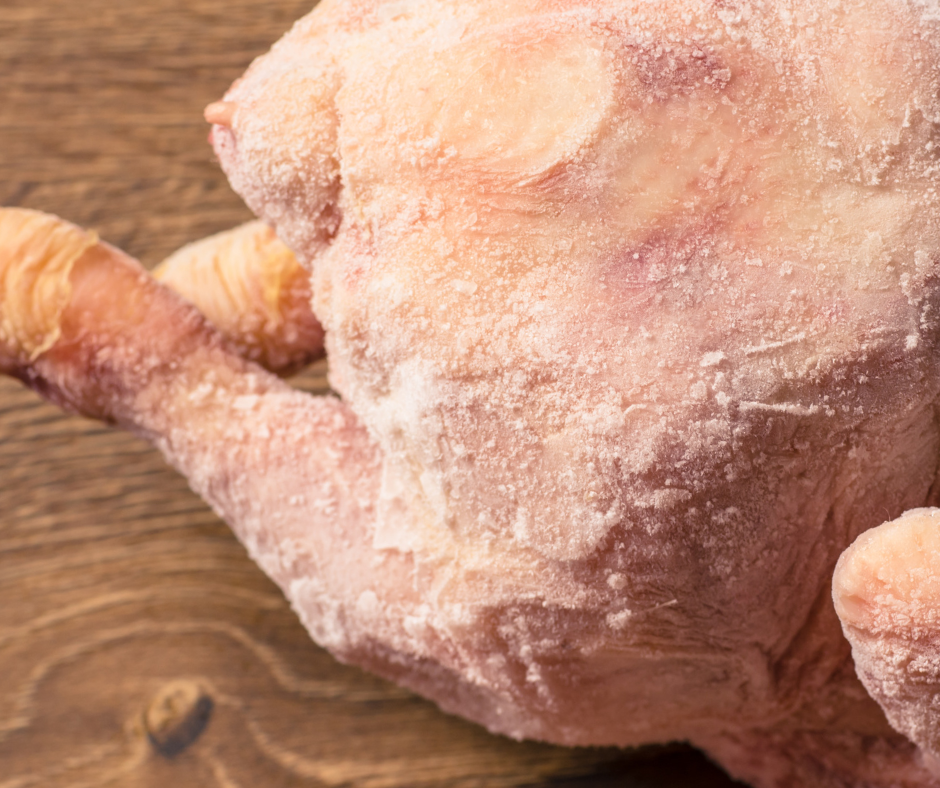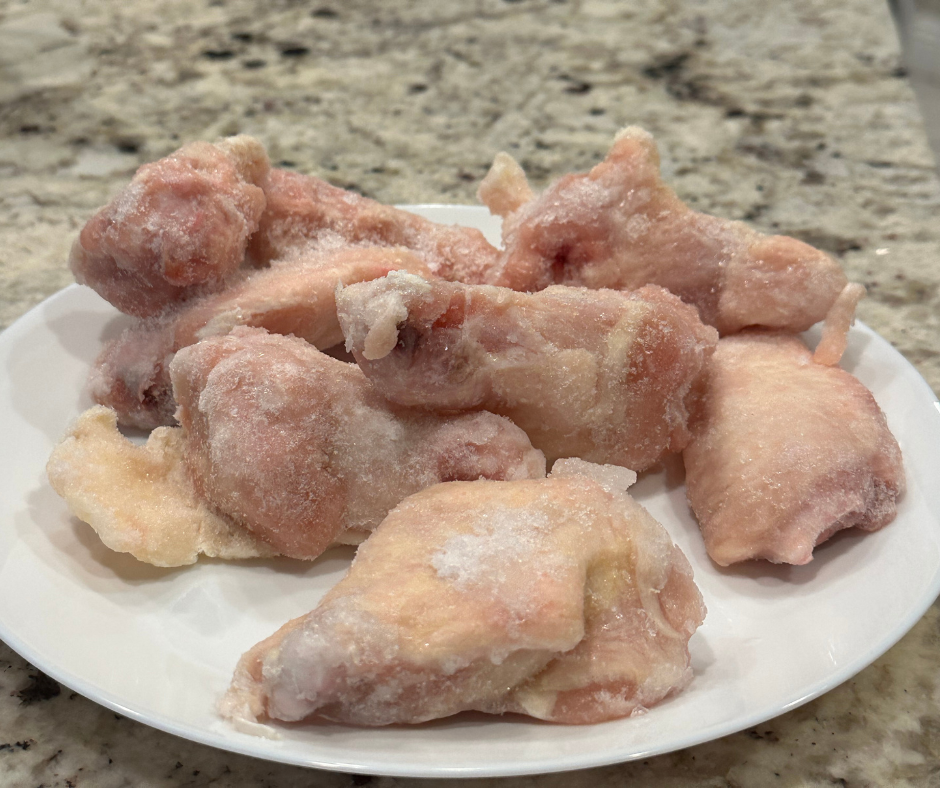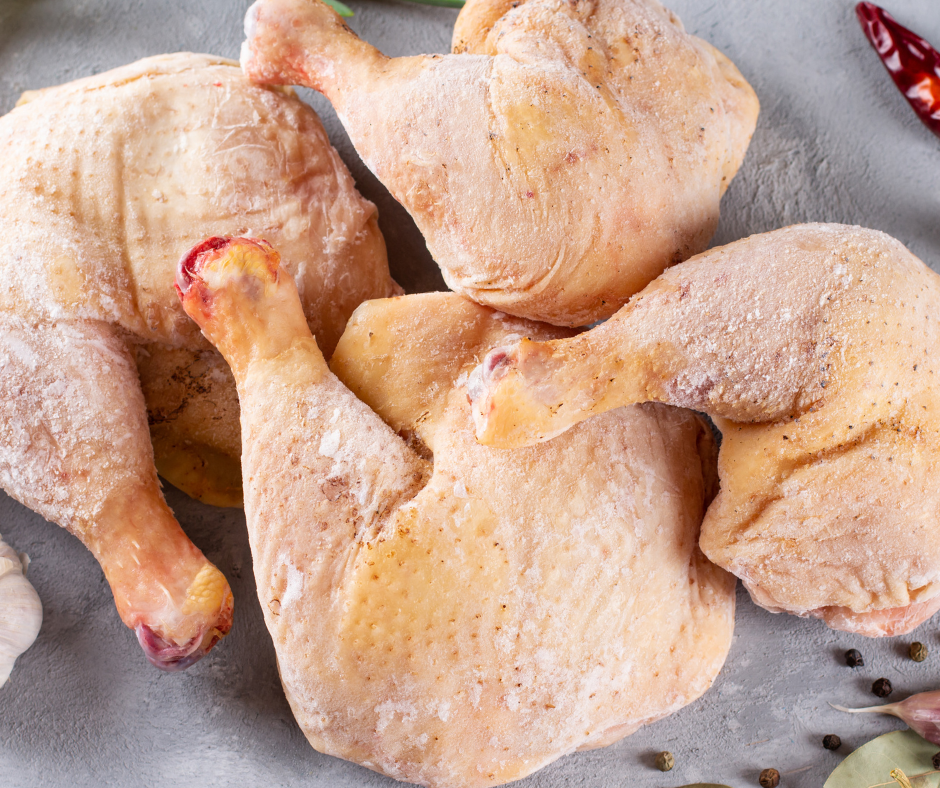Introduction
In food safety, it is crucial to understand ‘How Long Can Frozen Chicken Sit Out?‘ to mitigate potential health risks. As a responsible consumer, it is important to prioritize food safety guidelines to ensure your frozen chicken remains safe and free from harmful bacteria. Following these guidelines protects yourself and others who may consume the chicken. Let’s dive into the safety concerns regarding frozen chicken and the importance of food safety.
Safety Concerns Regarding Frozen Chicken
When it comes to frozen chicken, leaving it at room temperature for an extended period can pose significant risks. Food safety guidelines show frozen chicken should not be left at room temperature for 2 hours. Beyond this time, harmful bacteria can grow and multiply, increasing the risk of foodborne illnesses. These bacteria, such as salmonella and E. coli, can cause severe health issues if consumed.
Understanding The Importance Of Food Safety
Ensuring the safety of your frozen chicken and other food items should be a top priority. By adhering to proper food safety guidelines, you can prevent contamination and enjoy delicious and safe meals. Handling and storing food properly is essential to maintain its quality and minimize the risk of bacterial growth. This includes keeping frozen chicken at the appropriate temperature below 0°F (-18°C).
Following these food safety guidelines ensures your frozen chicken remains safe and free from harmful bacteria. It’s important to prioritize food safety to protect yourself and others from potential health issues. Always handle and store food properly to prevent contamination and enjoy delicious and safe meals.

Guidelines For Frozen Chicken
How Long Can Frozen Chicken Sit Out?
So, How Long Can Frozen Chicken Sit Out? Food safety guidelines show frozen chicken should not be left at room temperature for 2 hours. This timeframe is based on the fact that bacteria can multiply rapidly within this window, increasing the risk of foodborne illnesses.
Leaving frozen chicken at room temperature for an extended period creates an ideal environment for bacteria to grow and thrive. Harmful bacteria such as salmonella and E. coli can multiply quickly, posing a serious health risk if consumed. Therefore, it is important to always adhere to the 2-hour limit to minimize the potential for bacterial growth.
The Risk Of Harmful Bacteria Formation
When frozen chicken is left out at room temperature, its internal temperature rises gradually. This allows bacteria to multiply, especially when the chicken reaches temperatures between 40°F (4°C) and 140°F (60°C). The United States Department of Agriculture (USDA) advises that frozen chicken should not be left out for more than 1 hour, as it can quickly reach these temperatures and promote bacterial growth.
It’s important to prioritize food safety and understand the risks of leaving frozen chicken out. Following the 2-hour time limit can significantly reduce the risk of bacterial formation and subsequent foodborne illnesses.
Following these food safety guidelines ensures your frozen chicken remains safe and free from harmful bacteria. It is essential to prioritize food safety to protect yourself and others from potential health issues. Always handle and store food properly to prevent contamination and enjoy delicious and safe meals.
Remember, proper handling and storage practices, such as keeping frozen chicken at or below 0°F (-18°C), are vital to maintaining its quality and minimizing the risk of bacterial growth. Adhering to these guidelines ensures that your frozen chicken is safe to consume and enjoy without compromising your health.
Thawing Methods
Refrigerator Thawing: The Safest Approach
The refrigerator method is considered the safest approach when it comes to thawing frozen chicken. This method ensures that the chicken remains at a safe temperature (below 40°F/4°C) throughout the thawing process, minimizing the risk of bacterial growth. To thaw the chicken in the refrigerator, place the frozen chicken in a leak-proof plastic bag or airtight container and let it thaw slowly in the refrigerator. The general rule of thumb is to allow approximately 24 hours of thawing time for every 5 pounds of chicken. So, if you have a 10-pound chicken, it would take around 48 hours to thaw completely in the refrigerator.
Cold Water Bath And Microwave As Alternative Methods
If you need to thaw chicken more quickly, alternative methods are available. However, it’s important to note that these methods may not be as safe as refrigerator thawing.
One method is to use a cold water bath. To do this, wrap the frozen chicken in plastic wrap and place it in a leak-proof plastic bag. Submerge the bagged chicken in cold water, changing the water every 30 minutes to maintain a safe temperature. The chicken should thaw at a rate of about 30 minutes per pound. It is important to cook the chicken immediately after thawing using this method, as it will reach temperatures between 40°F (4°C) and 140°F (60°C), which can promote bacterial growth if left for too long.
Another method is to use a microwave. However, caution should be exercised when using this method, as microwaves can cause uneven thawing, leading to partially cooked areas that can harbor harmful bacteria. If you choose a microwave, follow the manufacturer’s instructions carefully and cook the chicken immediately after thawing to minimize the risk of bacterial growth.
In conclusion, thawing frozen chicken properly is crucial to ensure food safety. The refrigerator method is the safest, allowing for slow and consistent thawing. However, if you need to thaw chicken more quickly, consider using a cold water bath or a microwave. Just remember to cook the chicken immediately after thawing to minimize the risk of bacterial growth. Following these thawing methods, you can enjoy delicious and safe chicken meals while prioritizing food safety.

How To Thaw Frozen Chicken In The Fridge
The refrigerator method is considered the safest approach when it comes to thawing frozen chicken. This method ensures that the chicken remains at a safe temperature (below 40°F/4°C) throughout the thawing process, minimizing the risk of bacterial growth.
Using Leak-proof Containers
To thaw chicken in the refrigerator, using leak-proof plastic bags or airtight containers is important. This prevents any potential cross-contamination with other foods in the refrigerator. Place the frozen chicken in a leak-proof plastic bag or airtight container and let it thaw slowly in the refrigerator.
It is recommended to wrap the chicken properly and place it on a large plate at the bottom of the fridge to avoid any dripping onto other foods. This ensures proper food safety practices and maintains the quality of the chicken during the thawing process.
Time Variations Based On Chicken Size And Room Temperature
The thawing time for chicken in the refrigerator varies based on the size of the chicken and the room temperature. Generally, you should allow approximately 24 hours of thawing time for every 5 pounds of chicken.
For example, if you have a 10-pound chicken, it would take around 48 hours to thaw completely in the refrigerator. It is important to plan and allocate enough time for the chicken to thaw properly.
It is also worth noting that room temperature affects the thawing time. In warmer room temperatures, the chicken may thaw slightly faster, while in cooler room temperatures, it may take a bit longer. Monitoring the temperature and adjusting the thawing time ensures that the chicken thaws safely and maintains quality.
You can safely thaw frozen chicken using the refrigerator thawing while ensuring food safety. This method may take longer than other thawing methods, but it is the recommended approach to minimize the risk of bacterial growth.
Always follow proper food safety guidelines when thawing and handling chicken to prevent potential health risks. Following these thawing methods, you can enjoy delicious and safe chicken meals while prioritizing food safety.
Temperature Considerations
Regarding food safety, temperature plays a crucial role in preventing the growth of bacteria and ensuring that the food we consume is safe. This principle applies to frozen chicken as well. It’s important to understand the guidelines for how long frozen chicken can sit out at room temperature to minimize the risk of foodborne illnesses.
Above 90°F: Reduced Time Limit To An Hour
Food safety experts recommend that frozen chicken not be left out of refrigeration for more than two hours. However, if the temperature rises above 90°F (32°C), the time limit is reduced to one hour. Higher temperatures promote bacterial growth and increase the risk of food contamination.
When handling frozen chicken, it’s crucial to be mindful of the weather conditions and the temperature in your environment. Don’t leave it sitting out for extended periods, especially in hot climates or summer months. Always prioritize refrigeration to maintain the safety and quality of the chicken.
Importance Of Refrigeration
Properly storing frozen chicken in a freezer at 0°F (-18°C) is essential to keep it safe. Freezing slows down the movement of molecules, which causes bacteria to enter a dormant stage. However, once the chicken is thawed, these bacteria can become active and multiply rapidly, leading to potential foodborne illnesses.
To ensure food safety, always thaw frozen chicken in the refrigerator. The refrigerator method allows the chicken to thaw slowly at a safe temperature below 40°F (4°C), minimizing the risk of bacterial growth. Using leak-proof plastic bags or airtight containers is recommended to prevent cross-contamination. Place the chicken on a plate at the bottom of the fridge to avoid dripping onto other foods.
Additionally, it’s important to plan and allocate enough time for the chicken to thaw properly. The thawing time varies based on the size of the chicken and the room temperature. Generally, allow approximately 24 hours of thawing time for every 5 pounds of chicken. Monitor the room temperature and adjust the thawing time to ensure safe and high-quality chicken.
You can safely thaw and handle frozen chicken by following food safety guidelines, such as keeping track of time and prioritizing refrigeration. Remember, proper handling and adherence to temperature guidelines are crucial for preventing foodborne illnesses and ensuring the health and well-being of yourself and your loved ones.

Can Frozen Chicken Be Left Out Overnight?
The Regulated Temperature Of The Fridge
When it comes to food safety, it is crucial to prioritize the proper storage and handling of frozen chicken. Leaving frozen chicken out overnight is not safe and should be avoided. The regulated temperature of the fridge plays a significant role in preventing bacterial growth and ensuring the chicken remains safe to consume.
Food safety guidelines recommend that frozen chicken never be left at room temperature for two hours. Beyond this time, harmful bacteria can multiply and pose a food safety risk. Therefore, it is essential to promptly return frozen chicken to the refrigerator after use, as the fridge’s regulated temperature helps maintain the chicken’s quality and safety.
Contamination Risks And The Need For A Leak-proof Container
Leaving frozen chicken out overnight increases the risk of contamination and bacterial growth. When the chicken is not kept at proper refrigeration temperatures, bacteria can multiply rapidly, leading to potential foodborne illnesses.
To prevent cross-contamination and ensure the safety of the frozen chicken, it is crucial to store it in leak-proof plastic bags or airtight containers. This prevents any potential drippings from the chicken from contacting other foods, reducing the risk of bacterial transfer and contamination.
By following these food safety guidelines and avoiding leaving frozen chicken out overnight, you can minimize the risk of foodborne illnesses and ensure the health and well-being of yourself and others. Remember, prioritizing food safety is always important when it comes to the storage and handling of frozen chicken.
In conclusion, it is not safe to leave frozen chicken out overnight. Promptly returning the chicken to the refrigerator and storing it in leak-proof containers are essential to prevent bacterial growth and contamination. By adhering to these food safety guidelines, you can enjoy delicious and safe meals while prioritizing the well-being of yourself and your loved ones.
Conclusion
Now you should know the answer to ‘How Long Can Frozen Chicken Sit Out?’. Understanding the food safety guidelines for frozen chicken is crucial in ensuring the well-being of yourself and others. Following these guidelines will help prevent the growth and multiplication of harmful bacteria, safeguarding against potential health risks. Handling and storing frozen chicken properly is important to prevent contamination and enjoy delicious and safe meals. By prioritizing food safety, you can protect yourself and your loved ones from adverse consequences.
Understanding The Food Safety Guidelines For Frozen Chicken
To ensure the safety of frozen chicken, it is important to understand the recommended time limits for leaving it at room temperature. According to the United States Department of Agriculture (USDA) guidelines, frozen chicken should not be left at room temperature for 2 hours. Beyond this time, harmful bacteria can grow and multiply, posing a food safety risk.
Proper thawing techniques should also be followed to minimize the risk of bacterial growth. It is recommended to thaw frozen chicken in the refrigerator, as the regulated temperature helps maintain its quality and safety. Alternatively, you can use the cold water thawing method, where the chicken is placed in a leak-proof plastic bag and submerged in cold water. Changing the water every 30 minutes is important to ensure a safe thawing process.
Practicing Proper Thawing Techniques To Ensure Safety
When thawing frozen chicken, avoiding using the countertop or hot water methods is important. Thawing on the counter can allow bacteria to multiply rapidly, while hot water can partially cook the chicken and create uneven thawing, promoting bacterial growth.
By following proper thawing techniques, you can ensure the safety of your frozen chicken and minimize the risk of foodborne illnesses. It is crucial to prioritize food safety by correctly handling and storing frozen chicken to maintain its quality and prevent contamination.
In conclusion, understanding the food safety guidelines for frozen chicken and practicing proper thawing techniques are essential for ensuring the safety and quality of your meals. Following these guidelines will help prevent the growth of harmful bacteria and reduce the risk of foodborne illnesses. Always prioritize food safety and enjoy delicious and safe meals.
FAQ: How Long Can Frozen Chicken Sit Out? Food Safety Guidelines
Q: How long can frozen chicken sit out at room temperature?
A: Frozen chicken should not be left at room temperature for 2 hours. Bacteria can grow rapidly at temperatures above 40°F, increasing the risk of foodborne illness.
Q: What happens if frozen chicken is left out for too long?
A: If frozen chicken sits at room temperature for over 2 hours, it becomes susceptible to bacterial contamination. This can lead to food poisoning and other health risks when consumed.
Q: How should frozen chicken be stored?
A: Frozen chicken should be stored in a refrigerator with a temperature of 40°F or below. It should be used within 1 or 2 days or frozen at 0 °F for long-term storage. It will remain safe indefinitely if kept continuously frozen, although the quality may diminish over time.
Q: Can frozen chicken be refrozen after it has been thawed?
A: You can refreeze chicken that has been thawed but not cooked. However, it is important to note that refreezing may affect the quality and texture of the poultry. It is best to use thawed chicken within 3 to 4 days.
Q: How should chicken be thawed safely?
A: The safest ways to thaw chicken are in the refrigerator, in cold water, or in the microwave. Never thaw chicken on the counter or in other locations, as this promotes bacterial growth. Thawing in the refrigerator is the best method for slow and safe thawing.
Q: How can I ensure the safe handling of chicken?
A: When purchasing chicken, make sure it feels cold and select it before checking out at the register. To prevent cross-contamination, put packages of chicken in disposable plastic bags, if available, to contain any leakage. This will help protect other foods in your grocery cart or shopping bags.
Q: What temperature should chicken be cooked to?
A: Chicken should be cooked to an internal temperature of 165°F (74°C) to ensure it is safe to eat. This temperature helps kill any harmful bacteria that may be present.
Q: What are the four food safety steps to follow?
A: The four food safety steps recommended by the USDA Food Safe Families campaign are:
- Clean: Wash hands and surfaces often.
- Separate: Keep raw meats and poultry separate from other foods to avoid cross-contamination.
- Cook: Cook poultry to a safe internal temperature of 165°F (74°C).
- Chill: Refrigerate promptly to minimize the time bacteria can grow.
For more detailed information about bacteria and viruses associated with meat and poultry products, visit the relevant webpage provided. By practicing safe food handling and cooking techniques, you can help ensure your and your family’s safety from harmful bacteria.
Graham Bartlett, owner at Taco and Piña Mexican food, is all about bringing the authentic flavors of Mexico to your plate. With Graham Bartlett, you can tantalize your taste buds with mouthwatering tacos and delicious piña coladas, all in one place. Stay connected and never miss a beat as Graham Bartlett takes you on a culinary journey through vibrant Mexican cuisine. Join the community and discover the perfect blend of flavor, culture, and passion that Graham Bartlett brings to the table. Experience the essence of Mexico, one bite at a time, with Graham Bartlett.
